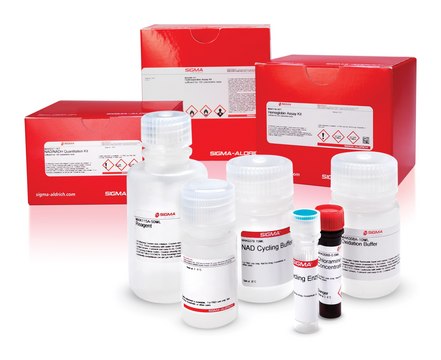추천 제품
재조합
expressed in E. coli
Quality Level
양식
buffered aqueous solution
특이 활성도
≥4.0 units/mg protein
분자량
130 kDa (homodimer)
130 kDa (subunit, homodimer)
UniProt 수납 번호
배송 상태
dry ice
저장 온도
−70°C
유전자 정보
mouse ... Nos2(18126)
유사한 제품을 찾으십니까? 방문 제품 비교 안내
일반 설명
Inducible nitric oxide synthase (iNOS), also known as inflammatory nitric oxide synthase, is a calcium independent isoenzyme, involved in synthesis of nitric oxide (NO). It is a soluble enzyme encoded by the gene mapped to mouse chromosome 11. iNOS is active in dimeric form and its activity is induced by cytokines and various other stimuli. iNOS is expressed in various inflammatory conditions.
애플리케이션
Nitric Oxide Synthase, Inducible from mouse has been used in immunohistochemical studies. It is also used to evaluate the therapeutic efficacy of inducible nitric oxide synthase (NOS) on reperfusion-induced microcirculatory alterations and hemodynamic adverse effects in the microvasculature of skeletal muscle.
생화학적/생리학적 작용
NOS is responsible for the biosynthesis of nitric oxide from L-arginine. iNOS is not calcium/calmodulin dependent and has a Km = 16 μM for L-arginine.
Tumor-derived inducible nitric oxide synthase (iNOS) plays a vital role in stimulating tumor growth and vessel maturation. Therefore, it is considered to be a potential therapeutic target for anti-vascular cancer therapies. Unchecked activity of iNOS leads to overproduction of nitric oxide (NO), which is toxic for living cells. iNOS activity can be controlled at both transcription and translational level by regulating protein stability, dimerization, phosphorylation, cofactor binding and availability of oxygen and L-arginine as substrates. iNOS plays a vital role in excisional wound repair and exhibits gene therapy strategy to advance wound healing process in iNOS-deficient conditions such as diabetes and steroid treatment.
단위 정의
One unit will produce 1.0 μmol of nitric oxide per minute at 37 °C in 50 mM HEPES, pH 7.4, containing 1 mM arginine, 1 mM magnesium acetate, 0.15 mM NADPH, 4.5 μM oxyhemoglobin, 18 μM tetrahydrobiopterin and 180 μM DTT.
물리적 형태
Solution in 50 mM HEPES, pH 7.4, with 10% glycerol, 8 μM tetrahydrobiopterin
Storage Class Code
10 - Combustible liquids
WGK
WGK 3
Flash Point (°F)
Not applicable
Flash Point (°C)
Not applicable
Investigating the role of tumour cell derived iNOS on tumour growth and vasculature in vivo using a tetracycline regulated expression system.
Papaevangelou E
International Journal of Cancer. Journal International Du Cancer, 138(11), 2678-2687 (2016)
Enhancing Nitric Oxide Bioavailability via Exogen Nitric Oxide Synthase and L-Arginine Attenuates Ischemia-Reperfusion-Induced Microcirculatory Alterations.
Engel H
Annals of Plastic Surgery (2014)
Mapping of the gene for inducible nitric oxide (NO) synthase of mouse macrophages to chromosome 11, close to Evi-2, nu, and Idd-4.
Jenkins NA
Genomics, 19(2), 402-404 (1994)
Reversal of impaired wound repair in iNOS-deficient mice by topical adenoviral-mediated iNOS gene transfer.
Yamasaki K
The Journal of Clinical Investigation, 101(5), 967-971 (1998)
Nitric oxide and nitric oxide synthase during
early lactation in water buffalo dams
early lactation in water buffalo dams
M.E. Pero
Rev. Med. Vet. (Toulouse), 157, 16-19 (2006)
문서
Oxidative stress is mediated, in part, by reactive oxygen species produced by multiple cellular processes and controlled by cellular antioxidant mechanisms such as enzymatic scavengers or antioxidant modulators. Free radicals, such as reactive oxygen species, cause cellular damage via cellular.
자사의 과학자팀은 생명 과학, 재료 과학, 화학 합성, 크로마토그래피, 분석 및 기타 많은 영역을 포함한 모든 과학 분야에 경험이 있습니다..
고객지원팀으로 연락바랍니다.




